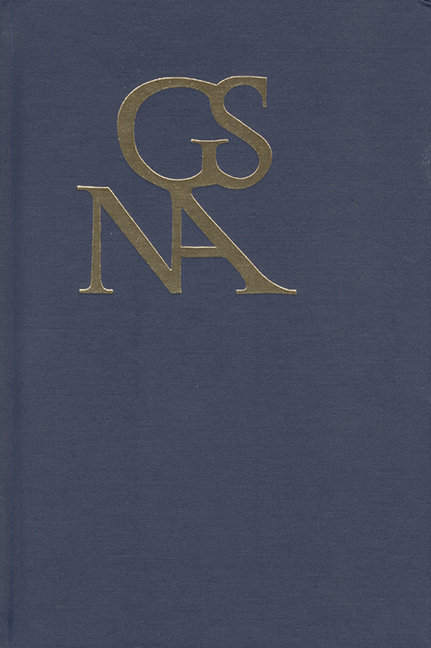Book contents
- Frontmatter
- Contents
- Special Section on What Goethe Heard, edited by Mary Helen Dupree
- What Goethe Heard: Special Section on Hearing and Listening in the Long Eighteenth Century
- Behind Herder's Tympanum: Sound and Physiological Aesthetics, 1800/1900
- Becoming the Listener: Goethe's “Der Fischer”
- Of Barks and Bird Song: Listening in on the Forgotten in Ludwig Tieck's Der blonde Eckbert
- Garden Empire or the Sublime Politics of the Chinese-Gothic Style
- Die Austreibung des Populären: Schillers Bürger-Kritik
- Goethe and the Uncontrollable Business of Appropriative Stage Sequels
- Repetition and Textual Transmission: The Gothic Motif in Goethe's Faust and “Von deutscher Baukunst”
- “Die gewalt'ge Heldenbrust”: Gender and Violence in Goethe's Iphigenie auf Tauris
- Literary Form and International World Order in Goethe: From Iphigenie to Pandora
- Two Gifts from Goethe: Charlotte von Stein's and Charlotte Schiller's Writing Tables
- Goethe's Wilhelm Meister and the Refusal to Grow Up: The Dialectics of Bildung
- “So steh' ich denn hier wehrlos gegen dich?”— Figures of Armament and Disarmament in German Drama before and after the French Revolution
- Goethe, Maimon, and Spinoza's Third Kind of Cognition
- Die Neuvermessung von Lyrik und Prosa in Goethes Novelle
- Book Reviews
Garden Empire or the Sublime Politics of the Chinese-Gothic Style
from Special Section on What Goethe Heard, edited by Mary Helen Dupree
Published online by Cambridge University Press: 16 May 2018
- Frontmatter
- Contents
- Special Section on What Goethe Heard, edited by Mary Helen Dupree
- What Goethe Heard: Special Section on Hearing and Listening in the Long Eighteenth Century
- Behind Herder's Tympanum: Sound and Physiological Aesthetics, 1800/1900
- Becoming the Listener: Goethe's “Der Fischer”
- Of Barks and Bird Song: Listening in on the Forgotten in Ludwig Tieck's Der blonde Eckbert
- Garden Empire or the Sublime Politics of the Chinese-Gothic Style
- Die Austreibung des Populären: Schillers Bürger-Kritik
- Goethe and the Uncontrollable Business of Appropriative Stage Sequels
- Repetition and Textual Transmission: The Gothic Motif in Goethe's Faust and “Von deutscher Baukunst”
- “Die gewalt'ge Heldenbrust”: Gender and Violence in Goethe's Iphigenie auf Tauris
- Literary Form and International World Order in Goethe: From Iphigenie to Pandora
- Two Gifts from Goethe: Charlotte von Stein's and Charlotte Schiller's Writing Tables
- Goethe's Wilhelm Meister and the Refusal to Grow Up: The Dialectics of Bildung
- “So steh' ich denn hier wehrlos gegen dich?”— Figures of Armament and Disarmament in German Drama before and after the French Revolution
- Goethe, Maimon, and Spinoza's Third Kind of Cognition
- Die Neuvermessung von Lyrik und Prosa in Goethes Novelle
- Book Reviews
Summary
SOON AFTER THE Storming of the Bastille in Paris shocked all of Europe on July 14, 1789, the Bavarian prince-elector Karl Theodor expedited the project of an English Garden and hastily opened this people's park (Volkspark) with a prominent Chinese tower (chinesischer Turm). The tower in Munich resembles the one in the royal gardens at Kew near London, which was designed and built by the royal architect to George III, Sir William Chambers, in 1762 (fig. 1). A prominent landmark in the metropolitan area of Munich, the English Garden, like Kew Gardens, is one of the earliest public parks in Europe and is meant to express Karl Theodor's gesture of generously sharing his property and governance with his people. Indeed, before and after Karl Theodor, German princes had a series of “Chinese” structures erected in their gardens and parks: the Chinese village Mulang in Kassel Wilhelmshöhe (built in 1781), the China House in Sanssouci, Potsdam (1764), the Chinese palais in the Steinfurter Bagno near Münster (1787), and, most conspicuously, the Chinese garden kingdom (Gartenreich) in Dessau/Wörlitz (1795–97) built by Leopold III of Anhalt-Dessau after his visit to England.
Unlike the French renaissance garden's strict geometrical regularity, the irregular style is often considered to be the English garden style. Yet Chambers forcefully claims in his A Dissertation on Oriental Gardening (1772) that the irregularity is actually Chinese. Indeed, garden design was a politically contentious issue between the royalist Tory party, to which Chambers belonged, and the liberalist Whig party in England. Stephen Bending explains: “The English landscape garden, then, is a reflection both of Britain's cultural disposition and of correct—natural—government, for if regular gardens represent despotic interests, the ‘rational’ landscape garden is a reflection of a variegated—constitutional—regime.” This conjuncture of style and politics reminds me of John Dixon Hunt's argument that a garden is designed to represent, not to imitate, in a specific iconographical context. Hunt calls the garden a fiction or “third nature” because of its complex relationship with nature and culture. In this fiction of Europe's “Chinese” gardens, as I will show in the ensuing pages, the particular style of Chinese structures of William Chambers's design, which I call the Chinese-Gothic style, reveals a royal representation of empire and an accompanying aesthetics of sublimity in the eighteenth century.
- Type
- Chapter
- Information
- Goethe Yearbook 25Publications of the Goethe Society of North America, pp. 77 - 96Publisher: Boydell & BrewerPrint publication year: 2018



